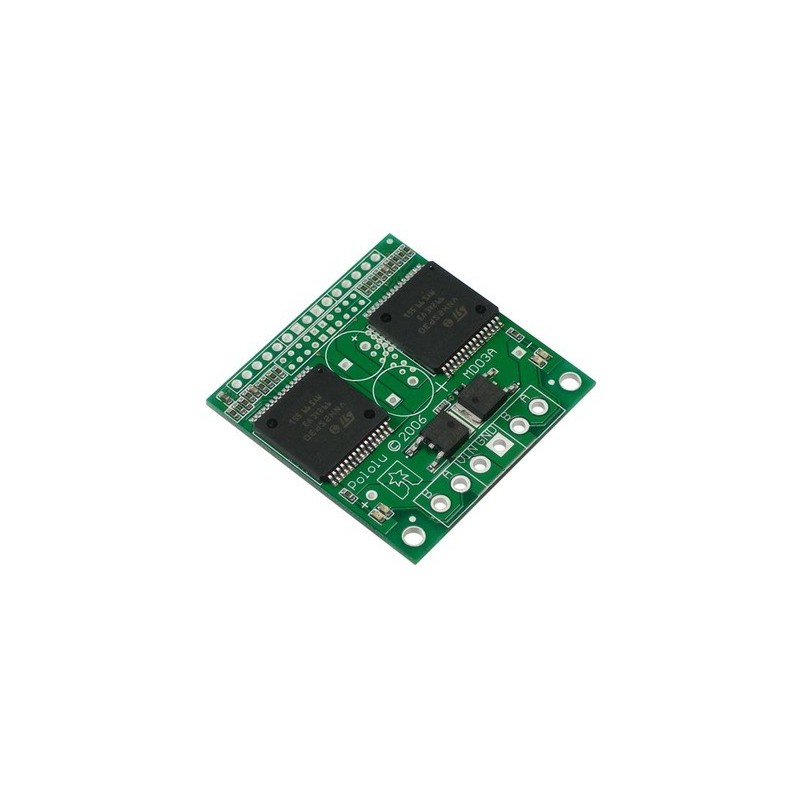



924,30 zł Netto
Dual VNH3SP30 Motor Driver Carrier MD03A umożliwia niezawodne sterowanie dwoma silnikami DC o dużym zapotrzebowaniu prądowym. Moduł sprawdza się w robotach i pojazdach mobilnych, gdzie wymagane pozostają kompaktowe wymiary, wysoka wydajność oraz odporność na przeciążenia. Pololu 707
Dual VNH3SP30 Motor Driver Carrier MD03A przeznaczony do sterowania dwoma silnikami prądu stałego w projektach robotycznych, mobilnych i mechatronicznych wymagających obsługi wysokich prądów. Moduł oparty na dwóch mostkach H VNH3SP30 umożliwia niezależną regulację prędkości i kierunku obrotów każdego silnika przy zachowaniu kompaktowej formy płytki nośnej.
Sterownik obsługuje sygnały logiczne kompatybilne z popularnymi mikrokontrolerami, umożliwiając sterowanie PWM oraz kontrolę kierunku obrotów. Zintegrowane zabezpieczenia przed przegrzaniem, przeciążeniem i zwarciem zwiększają niezawodność pracy w aplikacjach prototypowych i docelowych. Moduł znajduje zastosowanie w robotach mobilnych, pojazdach autonomicznych, platformach testowych oraz układach napędowych wymagających dużej mocy.
Cechy
Producent BTC Korporacja sp. z o. o. Lwowska 5 05-120 Legionowo Polska sprzedaz@kamami.pl 22 767 36 20
Osoba odpowiedzialna BTC Korporacja sp. z o. o. Lwowska 5 05-120 Legionowo Polska sprzedaz@kamami.pl 22 767 36 20
KAmod Motor Driver to zaawansowany sterownik silnika DC zasilany napięciem 6-30 V, umożliwiający regulację mocy metodą PWM oraz kontrolę kierunku obrotów, kompatybilny z sygnałami analogowymi i PWM z różnych źródeł, wyposażony w zabezpieczenia przeciążeniowe i termiczne oraz funkcje łagodnego startu i zatrzymania
Tic T834 USB Multi-Interface Stepper Motor Controller to sterownik silnika krokowego oparty na układzie DRV8834. Pozwala sterować silnikiem krokowym który napięcie na cewkę wynosi 2,5....10,8V, natomiast maksymalny prąd na cewkę wynosi do 1,5A. Sterownikiem można sterować przy pomocy: USB, TTL, I2C, RC (PWM modelarski), wejście analogowe czy enkoder kwadraturowy. Pololu 3132
Brak towaru
Pololu Simple High-Power Motor Controller 24v12
Brak towaru
Moduł sterownika silników DC z dwoma kanałami, dedykowany do stosowania w modelarstwie. Może być sterowany za pomocą nadajnika RC i wykorzystuje sygnał PPM. DFRobot DFR0513
Sterownik silników DC, który pozwala na kontrolowanie ruchu dwóch napędów za pomocą interfejsu I2C. Płytka bez złączy. Pololu 5056
Brak towaru
Dual MAX14870 Motor Driver to podwójny sterownik silników DC kompatybilny ze standardem Arduino pozwalający na wysterowanie dwóch silników DC napięciem 4,5-36V prądem ciągłym 1,7A. Pololu 2519
Sterownik silników DC, który pozwala na kontrolowanie ruchu dwóch napędów za pomocą interfejsu I2C. Płytka ze złączami do montażu. Pololu 5037
Brak towaru
Moduł sterownika silnika bezszczotkowego (regulator ESC) o wydajności prądowej do 35 A
Jednokanałowy sterownik silników DC z interfejsem I2C. Jest zasilany napięciem od 1,8 V do 22 V i może dostarczyć prąd o natężeniu do 1,8 A. Płytka ze złączami do montażu. Pololu 5075
Moduł zasilania wraz z sterownikiem silników stworzony specjalnie dla podwozia Romi Chassis. Z jego pomocą zasilimy wszystkie komponenty naszej konstrukcji oraz będziemy mieli możliwość sterowania silnikami odpowiedzialnymi za poruszanie się podwozia. Pololu 3543
Jednokanałowy sterownik silników DC umożliwiający sterowanie silnika napięciem z zakresu 6-30V oraz prądem do 13A. Umożliwia sterowanie prędkością silnika z użyciem sygnały PWM. Cytron MD13S
Podwójny sterownik silników DC przeznaczony dla Arduino, który umożliwia zasilanie silnika napięciem w zakresie 4,5-28V i poborze prądu przy pracy ciągłej 2,6A (5A w szczycie) dwóch silników DC. Pololu 2520
Zestaw zawierający sterownik Ardumoto w postaci shielda dla Arduino, dwa silniki prądu stałego, wraz z pasującymi kołami, oraz niezbędne złącza. SparkFun KIT-14180
Brak towaru
Sterownik, który umożliwia kontrolę dowolnego 3-fazowego silnika BLDC. Wyposażony został w wbudowaną łączność WiFi i Bluetooth oraz zintegrowany czujnik efektu Halla TMAG5273 i wzmacniacze czujników prądu INA240A1, dzieki czemu pozwala na wykrozystanie zaawansowanych algorytmów FOC. SparkFun ROB-22132
Jednokanałowy sterownik silnika DC o napięciu pracy od 8 do 28 V i prądzie ciągłym do 160 A. Może być sterowany sygnałem analogowym, PWM, UART, RC lub za pomocą wbudowanych przycisków. Cytron MDS160A
Brak towaru
Sterownik silnika krokowego z uładem DRV8825, pozwala na zasilanie silnika bipolarnego prądem do 1,5A na fazę. Możliwośc kontroli za pomocą interfejsów: I2C, szeregowego TTL, USB, a także potencjometru, enkodera lub STEP/DIR. Wersja z przylutowanymi złączami. Pololu 3130
Brak towaru

Dual VNH3SP30 Motor Driver Carrier MD03A umożliwia niezawodne sterowanie dwoma silnikami DC o dużym zapotrzebowaniu prądowym. Moduł sprawdza się w robotach i pojazdach mobilnych, gdzie wymagane pozostają kompaktowe wymiary, wysoka wydajność oraz odporność na przeciążenia. Pololu 707
